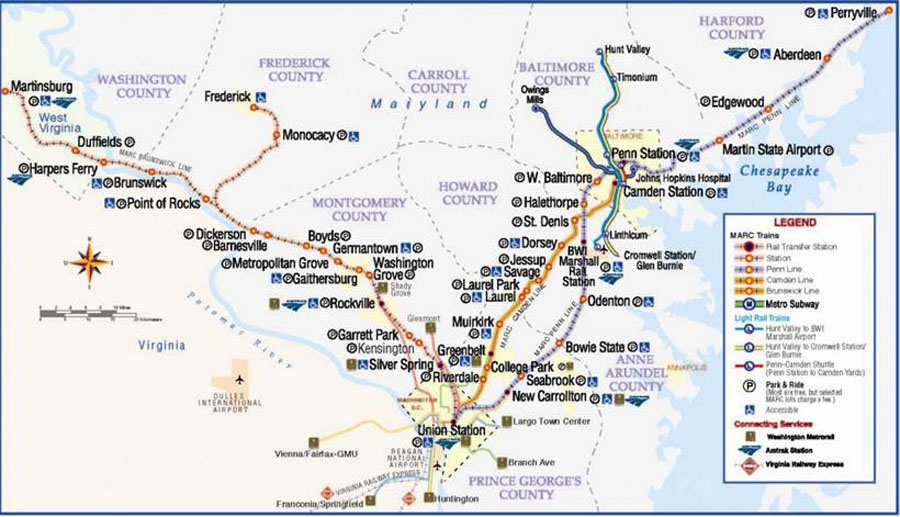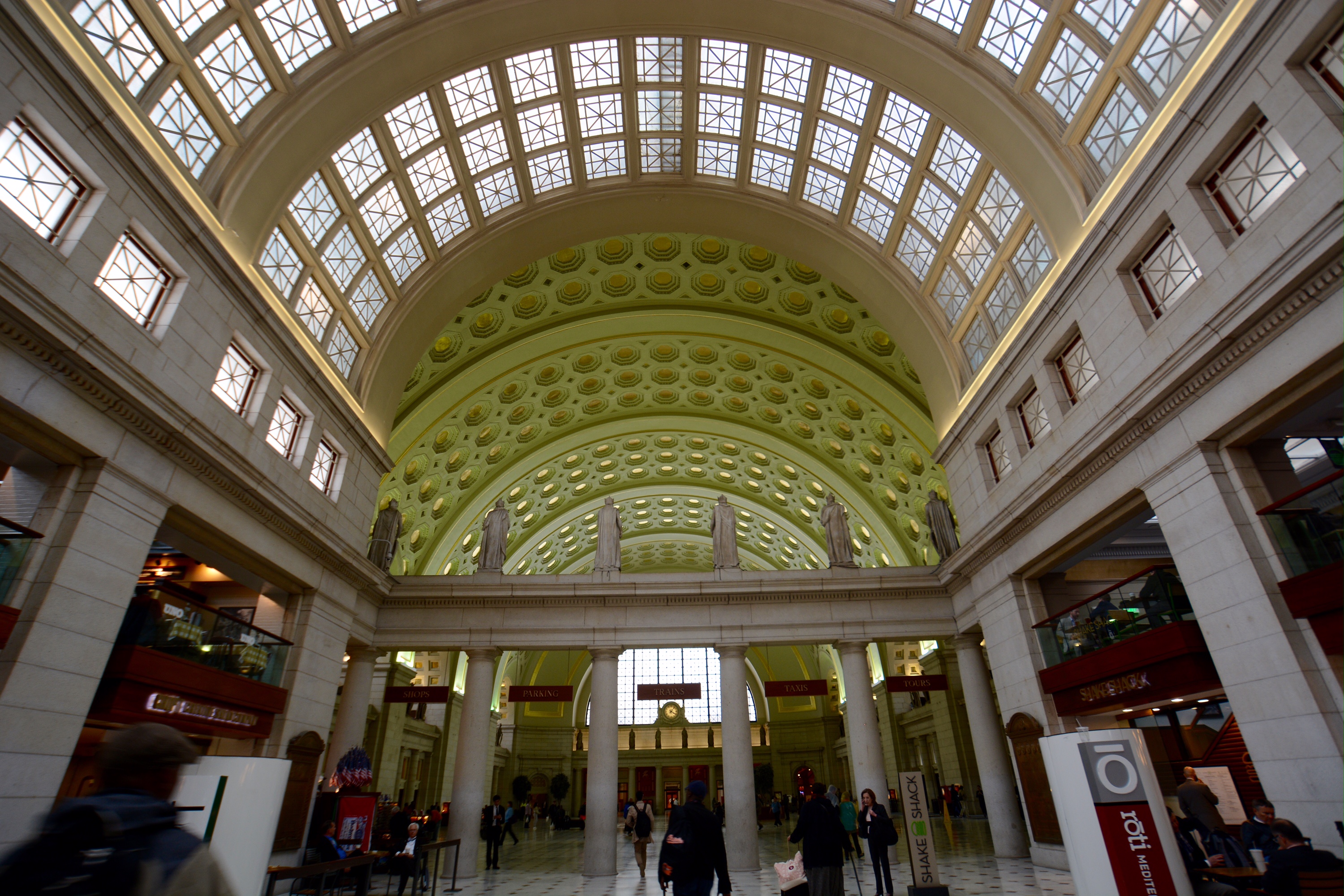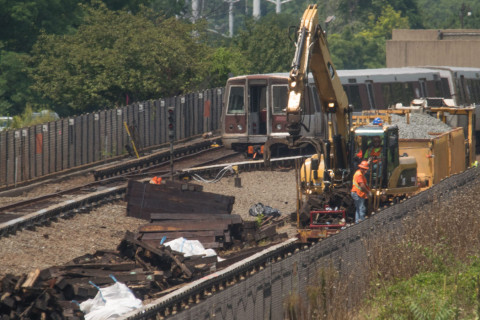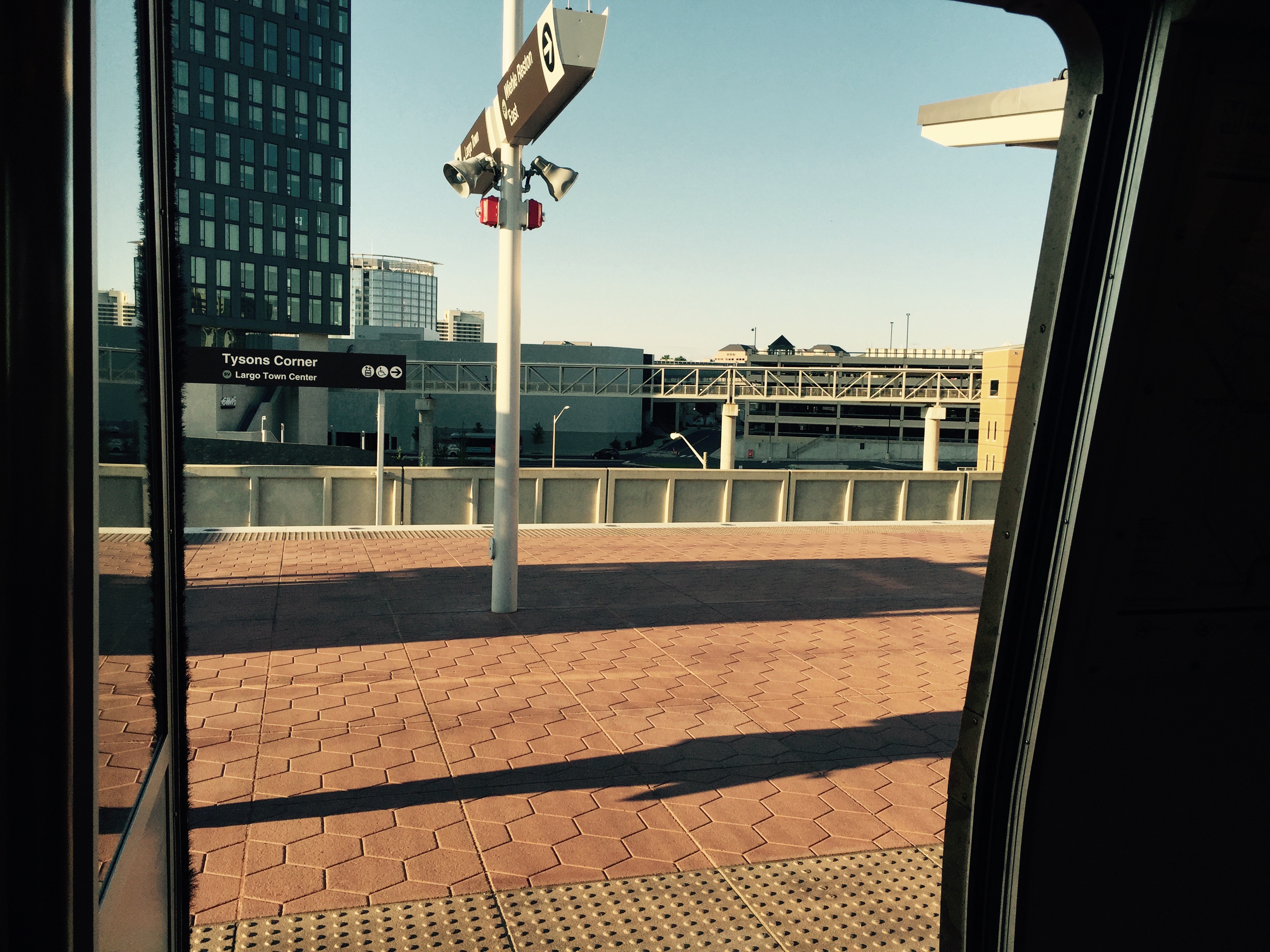UPDATE 12/14/16 1:50 p.m.: WTOP has learned this surge will end Dec. 20, with regular service resuming Dec. 21. Read more here.
WASHINGTON — Major disruptions on Orange and Silver lines are scheduled to run from the day many commuters return from Thanksgiving break until just a few days before Christmas.
Surge 11 includes round-the-clock single-tracking between East Falls Church and West Falls Church to deal with a number of issues, including basic repairs that have not been addressed for decades. Even though the work is in Virginia, there are also significant service impacts across D.C. and Maryland.
If riders respond in a similar way as they have during other work zones, it could also push more cars onto the road.
The work
With crews scheduled to rip out and replace crumbling rail ties among other things, the Orange and Silver lines are each only scheduled to run every 20 minutes, even at rush hour, for the length of this three-plus week surge.
Metro is not planning to run any additional Blue Line trains either, despite the extra slots available through the Rosslyn Tunnel, so there will be significantly longer scheduled delays at all stations between Wiehle-Reston East or Vienna and New Carrollton or Largo Town Center. Any significant increase on the Blue Line would be at the expense of rush-plus or regular Yellow Line trains, which Metro is not planning to cut.
“Blue and Yellow line trains currently operate on a three-minute headway on the portion of the system south of Pentagon, leaving no capacity for additional trains. That is why it is essential that all riders anywhere on the Orange and Silver lines consider alternate travel options or teleworking during the upcoming surge,” Metro spokesman Richard Jordan said in an email.
The cut in scheduled Orange Line service means only one-third of usually scheduled trains are expected to run across the entire length of the line, including between Stadium-Armory and New Carrollton. The cut is only slightly less on the Silver Line.
Unlike previous work zones in the area, Metro’s plans do not indicate any additional trains running between Ballston and New Carrollton.
At stations downtown between Rosslyn and Stadium-Armory, there will be slightly less than half as many trains as usual.
Between Stadium-Armory and Largo Town Center, a stretch served by both the Blue and Silver lines, about 40 percent fewer trains than usual are scheduled.
Metro expects increased crowding across Orange and Silver lines, and on the Blue Line downtown.
Metro is urging all riders on Orange and Silver lines to “consider alternate travel options and avoid traveling during rush hour if possible.”
The Red, Green and Yellow lines are not scheduled to be disrupted by this work.
The Maryland workarounds
Riders who typically use the New Carrollton end of the Orange Line who commute downtown may instead want to use the Green Line or MARC trains.
There is no additional Metrobus or TheBus service planned in Prince George’s County, despite the significant rail service cuts there. The service reduction on the New Carrollton end of the Orange Line at rush hour is the same level as on the Virginia side.
Riders can take the existing TheBus 15X route between New Carrollton and Greenbelt if the 35-minute trip makes sense.
For riders who choose to stick with Metro, there is typically parking available at Greenbelt, College Park and Prince George’s Plaza.
For drivers who choose to go to New Carrollton to take MARC’s Penn Line, be aware that Metro charges an additional fee to people who park in the Metro lot there but do not ride the system. While the regular cost at New Carrollton for someone who rides Metro is $5.10, anyone who pays by credit card or with a SmarTrip that was not just used to ride Metro is charged $8.85.
Most other MARC parking lots, including the smaller Bowie State and Seabrook lots, are free.
MARC’s Penn Line stops at Odenton, Bowie State, Seabrook and New Carrollton on the way to and from Union Station, with trains running in both directions seven days a week.
MARC’s Camden Line may work for other riders. It stops in Jessup, Savage, Laurel, Muirkirk, Greenbelt and Riverdale on the way to and from Union Station. It only runs Monday through Friday.

Riders should check schedules carefully to be sure the trains will work for them.
Ticket options for MARC trains include a one-way pass, a five-day weekly pass good from Monday to Friday, a seven-day weekly pass and monthly passes.
On the Penn Line, a trip between Seabrook or New Carrollton and Union Station costs $5 one-way. Bowie State or Odenton to Union Station costs $6.
On the Camden Line, one-way tickets between Greenbelt, College Park or Riverdale and Union Station cost $5. Trips between Union Station and Jessup, Savage, Laurel or Muirkirk cost $6.
A five-day weekly ticket for a $5 fare costs $37.50. For a $6 one-way trip, the five-day pass costs $45.
Riders used to taking MARC may also choose to change their commutes by remaining on the train to Union Station instead of transferring to Metro at New Carrollton.
Blue and Silver line riders in Prince George’s County have fewer alternative options.
MTA Commuter Bus or other existing Metrobus, TheBus or RTA routes are also options to reach other Metro lines, downtown D.C. or combine to reach other locations.
The D.C. workarounds
Riders who use the Orange, Blue and Silver lines in downtown D.C. might be better off considering buses that run through the city, biking around town or walking to other Metro lines.
The 30s bus routes run along much of the lines across the District, the X2 connects the Minnesota Avenue area to Union Station, Gallery Place and the White House, and Circulator
routes provide other options. To and from the Stadium-Armory area, the 96 bus connects to Capitol Hill, Union Station, U Street and Woodley Park.
There could be additional delays for commuter and other buses on Dec. 1 during the National Christmas Tree Lighting. Potomac and Rappahannock Transportation Commission’s afternoon commuter buses, for example, will only run to and from the Franconia-Springfield and Tysons Corner Metro stations to avoid the gridlock.
The Virginia workarounds
With colder weather moving in, there may be fewer people interested in the direct bike ride past this work zone along the Washington and Old Dominion and Custis trails, which could make other options besides driving even more important along the congested Interstate 66 corridor.
Buses
For Orange Line riders, Fairfax Connector is bringing back rush-hour express service during this surge between Vienna and the Pentagon. The service costs $4 and was popular during previous Orange Line work zones.
Fairfax Connector is also adding additional rush-hour service to Route 599 between Reston North Park and Ride and Pentagon
Some PRTC buses will shift later to account for potential delays. The last evening trips for the Linton Hall and Manassas Metro Direct routes will leave Tysons Corner Metro Station 15 minutes later than usual during this track work. PRTC recommends that Manassas-area riders consider taking an OmniRide commuter bus to the Pentagon to avoid the most significant delays. A new Gainesville-Pentagon route will also be an option when it launches Dec. 12.
Loudoun County Transit is rerouting all Potomac Falls buses to Ballston Metro Station during this work zone. The buses usually pick up and drop off at West Falls Church. The change means buses have a different schedule during the work zone.
Other Loudoun County routes will not change schedules, but the system has highlighted the buses that are scheduled to have the most reasonable wait for a train.
From Herndon, including for riders who typically use the Wiehle-Reston East Metro, options include the 5A Metrobus from Herndon-Monroe Park and Ride. The bus runs express to Rosslyn then L’Enfant Plaza. Because it is an airport express that serves Dulles International Airport, the fare is $7, even on the additional trips added during this work zone that do not serve the airport.
From East and West Falls Church, there are several different options during this work zone.
At rush hour, Metro is offering limited free shuttle buses running on several different routes:
- Ballston – Virginia Sq – Clarendon -Courthouse – Rosslyn every 10 minutes
- Ballston – Virginia Sq – Clarendon – Pentagon every 15-20 minutes
Riders could also take the 3Y bus, which runs from East Falls Church through Rosslyn to Farragut Square and McPherson Square, or the 15K or 15L between East Falls Church and Rosslyn. The buses charge the regular fare of $1.75.
Between Dunn Loring and Ballston, the 2A route also has additional rush-hour service during this work zone.
From Ballston, in addition to the shuttle buses and other options, the 38B bus has some additional service. The bus runs largely along the Orange Line in Virginia through Georgetown and Foggy Bottom to Farragut Square.
Blue Line trains could be even more crowded than usual through Rosslyn, so Metro is advising Blue Line riders to consider riding the Yellow Line across the river or taking buses that go downtown like the 16Y Columbia Pike route to Farragut Square and McPherson Square.
ART buses also provide additional options, including route 42 between Ballston, Clarendon and Pentagon, and route 43 between Crystal City, Rosslyn and Courthouse.
Trains
While some riders who typically drive north to the Orange Line may be able to reasonably drive to Blue or Yellow line stations, for most impacted by this work zone, the Virginia Railway Express offers the best backup option on the rails.
The VRE Manassas Line runs in the morning from Broad Run Airport to Manassas, Manassas Park, Burke Centre, Rolling Road and Backlick Road. Those trains stop at Alexandria, Crystal City, L’Enfant Plaza and Union Station. The trains generally return in the afternoon, although there are a handful of trains that run the other way.
From Rolling Road or Burke Centre to D.C., a single round trip costs $16.30, which is similar to the cost of Metro parking fees added to a maximum fare round-trip on Metro.
Discounts are available with a five-day or monthly pass. A five-day pass for that same trip costs $64.30.
Parking
All of the additional shuttle buses around Metro stations in Virginia could contribute to limited parking availability, especially around stations in Arlington. Drivers should look out for temporary no parking signs.
In the District, the extended rush-hour restrictions that were rolled out on major arteries starting in June remain in force.
Drivers must check signs carefully for extended rush-hour restrictions that now apply until 10 a.m. rather than 9:30 a.m. and until 7 p.m. rather than 6:30 p.m. on a number of roads.
Fairfax County notes that a number of free park and rides typically have open spaces each day, including Saratoga Park and Ride where there is express bus service to the Pentagon, and Rolling Valley Park and Ride where there is bus service to the Blue and Yellow lines.
What’s next
Metro announced Nov. 22 that future planned rush-hour track work zones would be delayed at least until February.
Chief Operating Officer Joe Leader said the track work needs that had been identified would be addressed by the end of spring, but that the surges would not resume until at least February. In the meantime, crews plan to largely focus on evening and weekend work in tunnels.
Metro had previously said work would shift back to the Blue and Yellow Lines in early January near Braddock Road.
That work zone was scheduled to be followed by a shutdown of the Blue Line between Rosslyn and Pentagon, before work returned to the area south of Braddock Road to address issues on the other track there.
The final scheduled surge was on the Green Line between College Park and Greenbelt. That was previously scheduled to run from late March into April, however Leader outlined plans that could see surges run into May.
Editor’s note: This story has been updated to reflect changes in Metro’s January plans and shuttle buses.







